 |
NG Express
THE
OFFICIAL NEWSLETTER OF THE PORT ELIZABETH APPLE EXPRESS
Postnet Suite 124, Private Bag 13130, Humewood, Port
Elizabeth |
June 2007
| THE STEAM TRUMPET
The following is an extract from the “The South Western
Gazette” of June 1st 1893.
The origin of the railway whistle is somewhat peculiar.
In the beginning of the year 1833, the engine ‘Samson’
running on the railway between Leicester and Swanington*
came into collision with a cart and horse. The cart was
loaded with beetroot and eggs for the Leicester market.
The engine driver could only use the horn he held in his
hand as a means of warning and the consequence was the
cart overturned.
The accident caused some confusion and Mr.Ashlett
Bagster, the director of the railway, went the very same
day to Alton Grange where George Stephenson resided to
consult with him. Bagster asked whether a whistle could
not be placed on the engine which would let off the
steam.
Stephenson replied that the idea was a good one and
worth trying. The first whistle was made by a musical
instrument manufacturer and gave such good results that
the Board of Directors decided to establish similar
whistles on all the company engines. As the company had
to pay for the horse and cart, 50 lbs of beetroot and
eighty dozen broken eggs, we may say that the whistle
has it’s origin in 960 broken eggs. |
|
After this, regulations were enforced which
forbade the circulation of locomotives which were not
furnished with a steam whistle or as it might well be
called in those days, a “steam trumpet”. Whistles as we
know them now were introduced into England in 1836 and
into France in 1837 on the first railway of St Germain.
We are told that Mr. Fyffe, Director of the Liverpool
and Manchester Railway was the first to introduce the
present day whistle in 1835. The early whistles
consisted of a cylindrical bell of great height with a
flat bottom very like the deep sounding sirens on steam
boats. Later on, the cylindrical bell was replaced by a
hemispherical one with a sharp sound. The old form of
whistle is sometimes to be met with on American
locomotives.
*Note. Leicester and Swanington Railway opened on the 4
July 1832 and was absorbed into the Midland Railway in
August 1845.
The above incident is purported to have occurred at
Bagworth on the 4th May 1833 but no written evidence
exists and the story must remain part of railway legend.
|
| WHERE ARE THEY NOW Since the
demise of steam on the narrow gauge railway here in the
Eastern Cape and the ‘take over’ by the Class 91 diesel
locomotives, a number of the steam locomotives that were
working on the Avontuur line have, over the years, been
sold to overseas buyers. Here is a list of where they
are now.
| LOCOMOTIVE
|
MNFG. |
WHERE NOW .. |
| NG 15 No. 18 |
1931 |
Texas USA Bob Boucher. |
| NG 15 No. 118 |
1938 |
Bennett Brook Railway, Perth, Australia. |
| NG 15 No. 120 |
1949 |
Welsh Highland Railway |
| NG 15 No. 121 |
1949 |
Peter Rampton, Surrey, UK |
| NG 15 No. 123 |
1949 |
Bennett Brook Railway |
| NG 15 No. 133 |
1952 |
Welsh Highland Railway |
| NG 15 No. 134 |
1952 |
Welsh Highland Railway |
| NG 15 No. 135 |
1952 |
Was with Exmoor Steam Railway, Devon,
UK. |
| NG 15 No. 136 |
1952 |
Schinznacher Baumfchunbahn, Switzerland.
|
| NG 15 No. 146 |
1957 |
Brecon Mountain Railway, Wales, UK |
| |
|
|
| NGG 16 No. 50 |
1928 |
Texas, USA, Bob Boucher |
| NGG 16 No. 60 |
1928 |
Schinznacher Baumfchunbahn, Switzerland. |
| NGG 16 No. 77 |
1928 |
Brecon Mountain Railway, Wales, UK |
| NGG 16 No. 78 |
1928 |
(Reported sold to Hanomag and in their
museum in Hanover.) |
| NGG 16 No. 82 |
1928 |
Peter Rampton, Surrey, UK |
| NGG 16 No. 87 |
1936 |
Exmoor Steam Railway?? |
| NGG 16 No. 109 |
1939 |
Exmoor Steam Railway ?? |
| NGG 16 No. 115 |
1939 |
Exmoor Steam Railway ?? |
| NGG 16 No. 129 |
1950 |
Puffing Billy Railway, Australia. |
| NGG 16 No. 130 |
1950 |
Exmoor Steam Railway ?? |
| NGG 16 No. 138 |
1958 |
Welsh Highland Railway. |
| NGG 16 No. 140 |
1958 |
Welsh Highland Railway. |
| NGG 16 No. 143 |
1958 |
Welsh Highland Railway. |
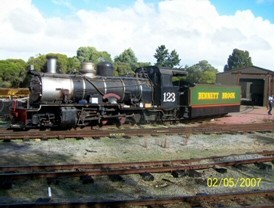
NG 15 No. 123 Bennett Brook Railway
Although not all the above locos are operational,
they will eventually be restored and be brought back
into service in their respective countries.
(Report
– Peter Burton)
|
|
LOCOMOTIVE NEWS The boiler tubes for NG 15
No. 119 have finally arrived. The two sets of tubes,
one set for No.119 and another for No. 124 were
recently delivered to the workshops at the Humewood
Road depot.
This is the first step toward getting these two
Kalahari’s back on the tracks. The tubes will in the
near future be sent to the steam workshops in George
to be swaged. Road trucks move fairly frequently
between Humewood Diesel depot and George, so it
shouldn’t be too long before work can recommence
with the rebuilding of loco No.119. |
|
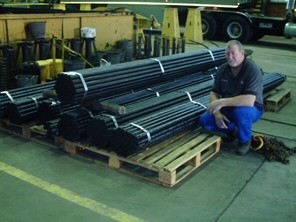
Boiler Tubes |
|
|
|
|
|
With
Garratt No. 131 being out of commission, it is great
to know that in the not too distant future we will
be able to see steam traction, at the head of the
train, once again. It looks like it will be a very
long time, though, before we see the Garratt in
action again. |
|
At
least we still have video available to remind us of
her glory days.
(See
HERE for a short video of the Garratt in
action.) |
| COACHING NEWS Work on the
coaches has come to a temporary standstill due to,
Clive Nel, our coach builder’s, illness. |
THE COUNTRY SCENE
Being a “country train” with its day trip terminus a
small village far from the bustle of city life,
there is always a surprise or two awaiting the
passengers at the Thornhill Station. For instance
the locals, especially the little ones, are always
there to welcome the train.

A welcoming committee
Then occasionally it is
not only humans that are around to welcome the train
but also our four legged friends wander by to say
hello.
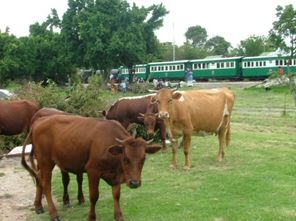
Farmyard Scene at Thornhill |
|
During the fruit season one is sure to find
the odd local trader arriving to try and tempt the
tourist with their juicy wares.
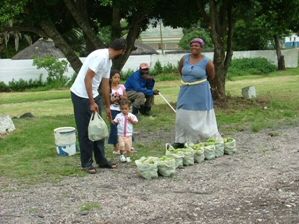
Prickly pears for sale.
Then in the village
itself it is not only motor cars that move down the
‘main’ street.
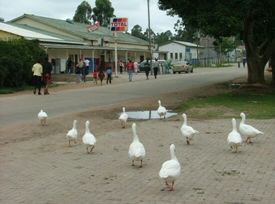
Goose stepping down Main Street
These are but a few of
the happenings that the Apple Express passengers are
bound to encounter when taking a day trip on the
train. |
| LOERIE TRIP On
17th June, Fathers Day, the train journeyed all the
way to Loerie station instead of doing the shorter
trip to Thornhill. The Loerie run is always
enjoyable, mainly due to the magnificent views
passengers have of the Loerie |
|
valley as the train slowly meanders down
the hillside toward the town. It was a wonderful
sunny day and the capacity crowd of passengers;
thoroughly enjoyed the day’s outing. |
| IN MEMORIAM
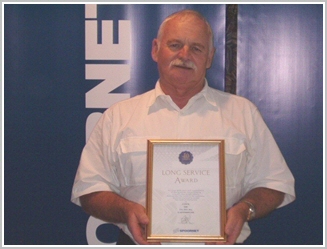 |
|
It is with deep regret that we report on
the recent tragic death of Andre Steyn (Junior
Manager – Learning and Performance, Spoornet).
Andre was one of the Apple Express’s most staunch
supporters. He was always ready to assist whenever
there was a problem that needed solving.
Like all of us, he was a lover of steam and
was, on many occasions, seen riding the footplate of
a locomotive, the only place on the train he enjoyed
being. He will be sorely missed by us all.
Rest in peace, Andre. |
|



